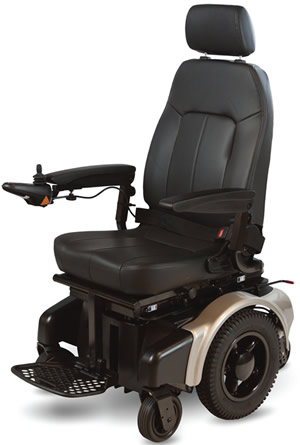Product Profile
Filling a Unique Mobility Niche
Shoprider's XLR14 Group 2 complex rehab chairs aren't full-blown CRT, but they help patients with needs that go beyond a basic, Group 1 device.
- By David Kopf
- Oct 01, 2018

Shoprider’s XLR14-CS (K0836) joins its siblings, the XLR14-SS (K0835) and XLR-Plus (K0823) to offer a number of features, including 300-lb. weight capacity, 50 degrees of available tilt, and a a minimum range of between 16 and 20 miles.
In today’s tight reimbursement environment, mobility providers are looking for solutions that help them more flexibly serve both patients’ unique needs and unique funding situations. To try and help them, Shoprider Mobility Products Inc. recently unveiled the XLR14, a set of Group 2 complex rehab chairs that straddle the line between complex rehab and standard power.
The line has three chairs:
- The XLR14-CS (K0836), which is a group 2 standard, single-power power wheelchair, with a captain’s seat.
- The XLR14-SS (K0835), which is also a group 2 standard, single-power power wheelchair, with a solid seat/back.
- The XLR-Plus (K0823), which has a captain’s chair and is designed for indoor/outdoor use.
There are some common traits to the three chairs: They can carry up to 300 pounds, have 50 degrees of tilt available, and a flip forward seat for easy battery access. The chairs also feature a self-adjusting, mid-wheel drive suspension system that includes four independently suspended front and rear casters to create six points of contact with the ground for a smooth driving experience And, since the XLR stands for extra-long range, the chairs have a minimum range of between 16 and 20 miles, depending on user weight and riding conditions.
The main difference between the XLR-Plus and its siblings the XLR14-CS and XLR14-SS is that the latter two have 14-inch drive wheels, while the Plus has 10-inch drive wheels and is designed for both indoor and outdoor use. The Plus is based on Shoprider’s previous Six Runner 10 Deluxe, while the CS and SS are brand new chairs.
Now, at this point, you’re probably wondering, what is the difference between a Group 3 and a Group 2 complex rehab chair? Despite the fact that the Group 2 codes have been on the books for years, general knowledge about Group 2 chairs is somewhat fuzzy in the industry. So, Shorprider has been trying to do some education in that regard with the debut of the new chairs, according to John Wright, executive vice president of sales management and business development for the company.
“The distinction is, if the patient has a neurological condition, then they automatically qualify for a Group 3 power chair,” Wright explains. “Because it’s assumed that their condition is going to change or require items that are not available on a Group 2 chair. For instance, we don’t have expandable electronics or the same top speeds.”
How unknown are Group 2 chairs? Wright says that he has seen multiple instances where therapists have prescribed more expensive Group 3 chairs for patients that don’t qualify for those chairs, but then down-coding against the K0835 and K0836 codes on the billing side — a nightmare for the bottom line.
“Historically, therapists have pushed for what patients want to make them happy and want the Cadillac every time,” Wright explains. “And that’s the problem. Some patients don’t qualify for a high-end, Group 3 chair.”
Key performance differences include the XLR’s minimum top speed of 4 mph (minimum for Group 2 chairs is 3 mph), compared to a Group 3 chair’s 4.5 mph; the XLR’s minimum obstacle climb of 40 mm (standard for Group 2 chairs), against a Group 3 chair’s 60 mm; and the XLR’s dynamic stability incline of 6 degrees (standard for Group 2 chairs), contrasted against a Group 3 chair’s 7.5 degrees. In terms of battery power, Group 3 chairs have a minimum range of 12 miles, while the XLR offers the aforementioned 16 to 20 miles, which is significantly better than a Group 2 chair’s minimum range of 7 miles.
To qualify for a Group 2 chair, the patient must satisfy all of these criteria:
- Beneficiaries have a mobility limitation that significantly impairs their ability to participate in one or more mobility-related activities of daily living (MRADLs).
- Their mobility limitation cannot be sufficiently and safely resolved by the use of an appropriately fitted cane or walker.
- Beneficiaries don’t have sufficient upper extremity function to self-propel an optimally-configured manual wheelchair in the home to perform MRADLs during a typical day.
- Beneficiaries aren’t able to safely operate a power mobility scooter.
All three chairs in the XLR line are on the market and available to mobility providers today.
XLR14
Shoprider Mobility Products Inc.
www.shoprider.com
(800) 743-0772
This article originally appeared in the October 2018 issue of HME Business.
About the Author
David Kopf is the Publisher HME Business, DME Pharmacy and Mobility Management magazines. He was Executive Editor of HME Business and DME Pharmacy from 2008 to 2023. Follow him on LinkedIn at linkedin.com/in/dkopf/ and on Twitter at @postacutenews.